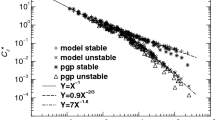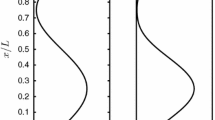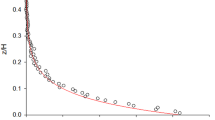Abstract
Although the random displacement model (RDM) represents the “diffusion limit” of the first-order Lagrangian stochastic (or “Langevin”) model of turbulent dispersion, we show that these provide distinct (numerical) solutions even for the case of a ground-level source, where intuition might suggest their solutions converge (i.e., the “far-field” model would suffice). We also demonstrate (analytically) that the discrete RDM does not preserve an initially well-mixed particle distribution—though the well-mixed ‘test state’ can be preserved to within an arbitrarily small error, by reducing the timestep. From a comparison with reference calculations calibrated to Project Prairie Grass, we conclude that the RDM provides in practice an adequate description of far-field dispersion, and so justifiably could be used as a replacement for grid-based Eulerian methods in simulation of medium- and long-range transport. However there can be an important loss of accuracy (for the test case examined, at least) if the timestep is not strictly limited, and we recommend instead the (generalized) Langevin treatment.
Similar content being viewed by others
References
Barad ML (1958) Project Prairie Grass, a Field Program in Diffusion (Vol. 2). Tech. rept. Geophysical Research Papers No. 59, TR-58-235(II). Air Force Cambridge Research Center
Batchelor GK (1957). Diffusion in free turbulent shear flows. J Fluid Mech 3: 67–80
Boughton BA, Delaurentis JM and Dunn WE (1987). A stochastic model of particle dispersion in the atmosphere. Boundary-Layer Meteorol 40: 147–163
Corrsin S (1974). Limitations of gradient transport models. Adv Geophys 18: 25–60
D’Amours R (1998). Modeling the ETEX plume dispersion with the Canadian emergency response model. Atmos Environ 32: 4335–4341
Durbin PA (1980). A random flight model of inhomogeneous turbulent dispersion. Phys Fluids 23: 2151–2153
Durbin PA (1983) Stochastic differential equations and turbulent dispersion. NASA Reference Publication 1103. NASA
Ermak DL and Nasstrom JS (2000). A lagrangian stochastic diffusion method for inhomogeneous turbulence. Atmos Environ 34: 1059–1068
Gardiner CW (2004) Handbook of stochastic methods for physics, chemistry and the natural sciences. 3rd edn. Springer Series in Synergetics. Springer, 415 p
Gradshteyn IS, Ryzhik IM (1980) Table of integrals, series and products. Academic Press. Corrected and enlarged edition, edited by A. Jeffrey, 1160 p
Haugen DA (1959) Project prairie grass, a field program in diffusion (Vol. 3). Tech. rept. Geophysical Research Papers No. 59, TR-58-235(III). Air Force Cambridge Research Center
Leone Jr JM, Nasstrom JS, Maddix DM (1997) A first look at the New ARAC Dispersion Model. American Nuclear Society’s Sixth Topical Meeting on Emergency Preparedness and Response, San Francisco, CA. April,1997
Luhar AK and Rao KS (1994). Lagrangian stochastic dispersion model simulations of tracer data in nocturnal flows over complex terrain. Atmos Environ 28: 3417–3431
Mooney CJ and Wilson JD (1993). Disagreements between gradient-diffusion and Lagrangian stochastic dispersion models, even for sources near ground. Boundary-Layer Meteorol 64: 291–296
Nasstrom JS and Pace JC (1998). Evaluation of the effect of meteorological data resolution on Lagrangian particle dispersion simulations using the ETEX experiment. Atmos Environ 32: 4187–4194
Pahlow M, Parlange MB and Porté-Agel F (2001). Monin-Obukhov similarity in the stable atmospheric boundary layer. Boundary-Layer Meteorol 99: 225–248
Panofsky HA (1973) Tower micrometeorology. In: ‘Workshop on Micrometeorology’, American Meteorol. Soc. Chap. 4, pp. 151–176
Pasquill F (1974) Atmospheric diffusion. J. Wiley and Sons, London, 297 pp.
Sawford BL (1985). Lagrangian statistical simulation of concentration mean and fluctuation fields. J Climate Appl Meteorol 24: 1152–1166
Sawford BL (2001) Project Prairie grass—a classic atmospheric dispersion experiment revisited. 14th Australian Fluid Mech. Conference
Sawford BL, Guest FM (1988) Uniqueness and universality of Lagrangian stochastic models of turbulent dispersion. Preprints of 8th symposium of the American Meteorol. Soc. on Turbulence and Diffusion, San Diego, pp. 96–99
Stull RB (1988) An introduction to the boundary layer meteorology. Kluwer Academic Publishers, Dordrecht, 666 pp
Thomson DJ (1987). Criteria for the selection of stochastic models of particle trajectories in turbulent flows. J Fluid Mech 180: 529–556
Wilson JD (1982a). An approximate analytical solution to the diffusion equation for short-range dispersion from a continuous ground-level source. Boundary-Layer Meteorol 23: 85–103
Wilson JD (1982b). Turbulent dispersion in the atmospheric surface-layer. Boundary-Layer Meteorol 22: 399–420
Wilson JD (2007) Turbulent velocity distributions and implied trajectory models. Boundary-Layer Meteorol. (in press)
Wilson JD and Flesch TK (1993). Flow boundaries in random flight dispersion models: enforcing the well-mixed condition. J Appl Meteorol 32: 1695–1707
Wilson JD, Thurtell GW and Kidd GE (1981a). Numerical simulation of particle trajectories in inhomogeneous turbulence. I. Systems with constant turbulent velocity scale. Boundary-Layer Meteorol 21: 295–313
Wilson JD, Thurtell GW and Kidd GE (1981b). Numerical simulation of particle trajectories in inhomogeneous turbulence. III. Comparison of predictions with experimental data for the atmospheric surface-layer. Boundary-Layer Meteorol 21: 443–463
Author information
Authors and Affiliations
Corresponding author
Rights and permissions
About this article
Cite this article
Wilson, J.D., Yee, E. A critical examination of the random displacement model of turbulent dispersion. Boundary-Layer Meteorol 125, 399–416 (2007). https://doi.org/10.1007/s10546-007-9201-x
Received:
Accepted:
Published:
Issue Date:
DOI: https://doi.org/10.1007/s10546-007-9201-x




